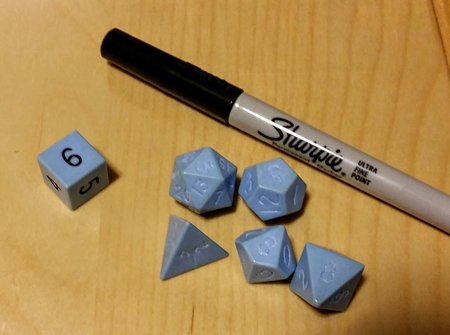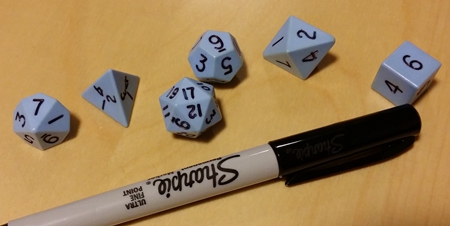I’ve discovered that if I’m careful I can de-ink — de-crayon, really — old precision-edge dice, then ink them anew with a Sharpie. My first real test of this was tonight, using the dice from my Cook Expert set. They’d been nicely crayoned years ago (by someone else), but crayon isn’t really my jam.[1]
Here are my Cook dice, all cleaned up and with the d6 re-inked:

Needle me, baby
I use a sewing needle (the kind with the little plastic ball on the butt end) to pick out the crayon. I start on the end of a number (any end), slip the needle in, and gently push forward while popping it up. Sometimes the whole number will just come right out in one piece; more often, it comes out in little bits after some poking around.
I do one pass, then massage the die under hot water (as hot as my hands can take), then do another pass with the needle, and then finally clean the dice with hand soap and hot water. I dry them off with a paper towel and let them sit for a couple of minutes. The whole process takes several minutes a die, and the smaller the numbers the harder they are to pick clean.
Based on a recommendation I found on an old-school gaming blog, I use an ultra-fine point Sharpie (paid link), which is a perfect fit for the grooves. So far, it’s fit both some Gamescience dice I experimented with and these old TSR dice (which may have also been made by Gamescience, I’m not sure).
I’ve found that the crayon doesn’t need to be 100% removed — just get as close to 100% as you can. The Sharpie will push around or cover over little flecks as you run it up and down the grooves.
The results
Here’s how my Cook dice turned out:

I’ve tried a few colors on gem dice, and they don’t show up at all. In the past, I’ve also used the white paint markers, and the points are just wide enough to spill over the edges of the grooves. I’m going to fiddle with some of those options as I acquire other precision-edge dice. If my fiddling is productive, I’ll post about it here.
[1] I find that crayon-inked dice look great at first, and I enjoy the actual inking process. But the crayon chips, rubs away, and gets banged up by the other dice in my bag, and over time that just kind of bugs me. I prefer a cleaner, more permanent solution. These won’t be perfect, and all of my favorite dice are all worn and dinged up in any case, but I can’t get past the crayon.

Have you tried a toothbrush to get the crayon out?
I have not, but that sounds like a great approach. I bet it’s faster than my sewing needle technique, too.
I find it a useful dexterity exercise to number several faces in contradiction to the cast-in numbers. turning a 15 into another 18, 10 into a second 20 and so on. It is quite challenging to do it in a convincing manner.
I have found, however, that some gamers can be very sensitive to the use of the dice marked in that way, so take care never to actually use them in a game where people have seen the dice close up.
Kidding, of course.